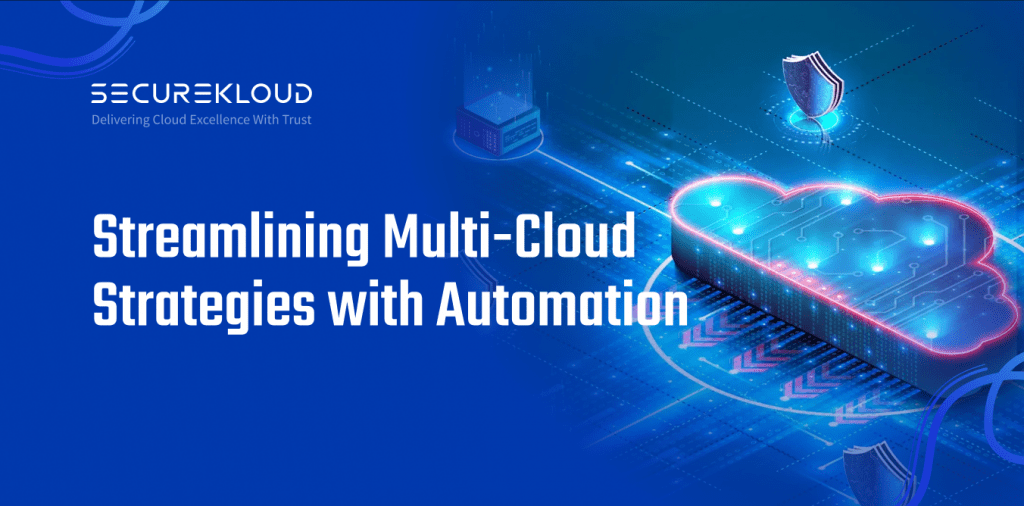- 4Minutes
- 748Words
- 86Views
As businesses increasingly adopt multi-cloud strategies to avoid vendor lock-in, enhance flexibility, and improve performance, managing multiple cloud environments can become complex and resource-intensive. While multi-cloud strategies offer significant advantages, they also bring a range of challenges, including increased management overhead, inconsistent performance, and potential cost inefficiencies.
In this blog, we’ll explore how automation can simplify multi-cloud management and help businesses enhance their cloud strategy optimization.
What is Multi-Cloud Strategy?
A multi-cloud strategy refers to the practice of using services from more than one cloud provider to meet specific business needs. This approach allows organizations to avoid being overly dependent on a single cloud vendor, enabling them to leverage the best services from each provider based on their unique requirements. For example, a business might use one cloud provider for computing power, another for storage, and yet another for specialized AI or machine learning services.
The Role of Multi-Cloud Automation in Streamlining Operations
Multi-cloud automation is the process of automating the management, deployment, and orchestration of services across multiple cloud environments. It helps businesses overcome the challenges of using multiple cloud providers by offering a centralized platform for managing workloads, scaling resources, and monitoring performance.
By integrating automated cloud tools into their multi-cloud strategy, businesses can significantly reduce manual interventions, streamline operations, and enhance their overall cloud performance. Here’s how automation can simplify multi-cloud management:
- Centralized Management: Managing multiple cloud providers can lead to a fragmented environment, where each platform operates independently. Multi-cloud automation allows organizations to unify their management layer, providing a single point of control for all cloud environments. This centralized approach enables businesses to automate deployment, resource provisioning, monitoring, and scaling across multiple clouds, saving time and reducing complexity.
- Optimized Resource Allocation: One of the main challenges in multi-cloud environments is ensuring that resources are optimally allocated across different platforms. By using automated cloud tools, businesses can analyze workloads in real-time and dynamically allocate resources to the most suitable cloud environment based on performance, cost, or availability. This automated resource management ensures that businesses only pay for what they need, enhancing cloud strategy optimization.
- Cost Management and Reduction: Managing costs across multiple cloud environments can be complicated, especially when it comes to tracking usage and optimizing spending. Multi-cloud automation helps organizations automatically track cloud usage, identify underutilized resources, and adjust resource allocation accordingly. Automated tools can also provide cost forecasting, helping businesses plan their budgets and avoid unexpected expenses.
- Improved Security and Compliance: Multi-cloud environments often mean dealing with different security protocols, compliance standards, and governance policies for each cloud provider. Automation tools can help enforce consistent security policies across all cloud platforms, automatically patch vulnerabilities, and ensure that compliance requirements are met. By using automated tools to monitor security, businesses can reduce human error and minimize the risk of breaches.
- Seamless Disaster Recovery and Business Continuity: In a multi-cloud setup, disaster recovery (DR) becomes even more critical. Automation helps businesses streamline their DR strategies by automatically replicating data across multiple cloud environments, ensuring that if one provider experiences an outage, data and services can quickly be restored from another cloud. Automated failover systems can detect disruptions and automatically switch to backup cloud environments, ensuring minimal downtime and business continuity.
Cloud Strategy Optimization with Automation
- Increased Efficiency: Automation reduces the need for manual intervention, enabling faster response times, reducing human error, and allowing teams to focus on more strategic tasks.
- Scalability: Automated systems can scale up or down based on demand, ensuring that resources are always available when needed without overprovisioning or underutilizing cloud resources.
- Performance Monitoring and Optimization: Automated tools can continuously monitor cloud environments for performance issues, offering recommendations and taking corrective actions without manual input. This ensures that workloads are always running at peak efficiency.
Incorporating multi-cloud automation into a cloud strategy is no longer just a nice-to-have—it’s essential for businesses looking to streamline their multi-cloud environments and optimize their overall cloud strategy. By using automated cloud tools, organizations can reduce complexity, enhance resource allocation, manage costs effectively, and improve security and performance across their cloud environments.



